Matador Network's Blog, page 601
August 27, 2021
IKEA will sell renewable energy through an app, no solar panels required

This is The Climate Win, the most positive sustainability news around the world every week.
Swedish home supply retailer IKEA announced that its Swedish customers can now purchase solar and wind power through a new service called STRÖMMA. The company is on a mission to become carbon positive by 2030. Customers will no longer need to have their own solar panels to power their homes sustainably.
This new offering adds to the IKEA renewable energy offerings, which already include solar panels and installation contracting for customers in over 10 markets globally. IKEA has not yet announced plans to sell solar panels or offer clean power via STRÖMMA in the United States, though it hopes to do so eventually.
“Today we offer smart and energy efficient products and services that contribute to prolonging the life of products, reducing waste, saving water, and eating more healthily, as well as reducing electricity usage. Providing solar and wind power at a low price to more people feels like the natural next step on our sustainability journey,” said Bojan Stupar, Sales Manager at IKEA Sweden, in a press release announcing the program.
STRÖMMA is Swedish for “flow.” This IKEA renewable energy program works like a combination utility company and solar panel provider, effectively bringing the entire process of going solar, or at least purchasing solar and wind power for the home, under one roof. Customers in countries including Sweden and the UK can buy solar panels and have them installed on their home. They can then use the app service to track usage and sell back excess power to the company, much like customers in parts of the United States can sell back excess solar power to their local utility.
Now, Swedish customers without solar can use the app to purchase solar and wind power for their home through Ingka Group, the largest operator of IKEA stores and warehouses worldwide. This service turns solar and wind power into a commodity purchasable as direct units and amounts, a major step forward from the “all or nothing” approach that many household customers in the majority of western countries have as their only option. In addition to helping customers reduce their carbon footprint at home, it works towards the company’s carbon positive goal by reducing the post-purchase footprint of their products, which the company estimates accounts for 20 percent of its total carbon footprint.
“We believe the future of energy is renewable and we want to make electricity from sustainable sources more accessible and affordable for all”, Jan Gardberg, New Retail Business Manager at Ingka Group, said in the release.
This concept would likely face immense pushback from utility companies in the United States, many of which already lobby against the practice of “net metering” that allows residential account holders to sell excess power back to the grid. But there’s still a major win for US residents to take away from STRÖMMA’s release on the other side of the Atlantic. The program will prove that buying solar and wind power through an app on their phone is possible. This opens up access to renewable energy to a wide range of people who cannot put solar panels on their homes — whether that be for financial reasons or because they live in high-density or covenant-controlled areas where it isn’t possible on their property. Customers who live in areas without enough regular sunshine to fully power their homes also stand to benefit.
It’s only a matter of time before visionary entrepreneurs and/or consultting firms working for major utilities bring the practice to the United States and other countries. Some major utilities in the US already offer an option for customers to purchase renewable energy credits. These programs, typically a small additional cost to the customer’s existing utility bill, invest that money in renewable energy infrastructure. A prime example of this is the Windsource program from Xcel Energy, which from 2003 until 2020 was available to customers in Minnesota, Colorado, and other states where Xcel operates. The program disbanded in Minnesota last year due to a significant drop in the price of wind power that made the additional cost unnecessary — which speaks well to the future of renewable energy and the technologies like STRÖMMA that distribute it.
More climate wins this weekA report from Quartz this week highlighted another country that could benefit big from sustainability developments in the coming years. The economy of India could grow $11 trillion by 2070 if the country can decarbonize and subsequently “export decarbonization to the world.” Basically, the country’s major industries, including retail, energy, and manufacturing, could lose massive financial input if the country fails to act, but stand to gain substantially if it does through exporting of the goods produced. Increasing consumer demand for sustainable products and sustainable tourism will amplify this.
Norwegian company Wind Catching Systems has designed a massive offshore floating wind farm that can power 80,000 homes, De Zeen reported. The Windcatcher, as it’s called, looks more like a giant Connect 4 board than a traditional wind turbine, but who cares — as long as it works.
And finally, a new thru-hike connecting Europe and Asia through the Caucasus Mountains is under construction. Its efforts seek to highlight the region’s beauty, amplify conservation efforts, and make for one epic trek. The best part: You can help make it happen. 
More like thisNewsIf you’re a traveler or digital nomad, there’s a climate-friendly bank for you
The post IKEA will sell renewable energy through an app, no solar panels required appeared first on Matador Network.
Stay in an iconic 4-star Chicago hotel on the riverwalk for just $169
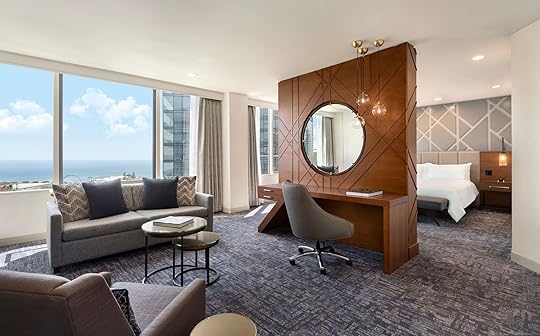
We hope you love the spaces and stays we recommend! Just so you know, Matador may collect a small commission from the links on this page if you decide to book a stay. Listed prices are accurate as of the time of publication. See our full Advertiser Disclosure here.
Chicago hotel deals are often tough to come by during the busy season, but we have two for you right here.
Chicago’s Swissotel is among the city’s most iconic buildings and a regular standout on its popular riverboat architecture tours. This Travelzoo deal puts you in the iconic hotel for between $109 and $169 per night, depending on when you travel. Through the fall season, the rate is $169 per night, a savings of nearly 50 percent of the normal price for a stay at Swissotel. There’s no better hotel to experience Chicago’s famed riverwalk — the boat tours, as well as many of the city’s top restaurants and museums, are located within walking distance or a quick Uber from the property.
On top of its central location in the heart of Chicago, Swissotel offers amenities you’re generally more likely to find at a luxury beach resort. The $20 daily resort fee covers fitness classes with a smoothie, morning coffee and tea, and fast WiFi throughout the hotel. The fitness center is on the hotel’s 43rd floor and offers incredible views of the skyline and city below.

Photo: Swissotel
Book now for your chance to stay in an iconic Chicago property at a budget rate. And if you change your mind and decide not to travel, Travelzoo will refund your purchase in its entirety. Chicago is best in autumn when the season’s colors drape the city parks. Don’t miss out.
Price:$109 to $169 per night
Stay in a Wrigleyville ‘friends’ unit’ with your entire crew for just $570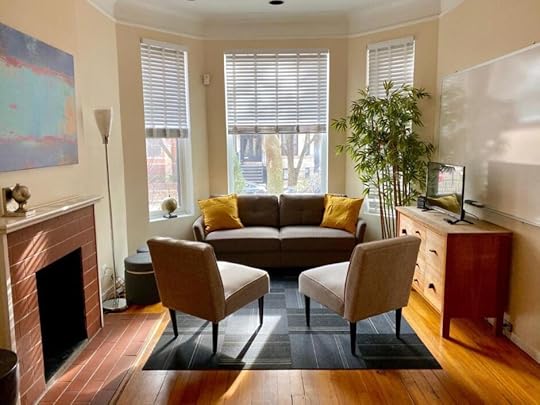
Photo: Booking.com
Wrigleyville is as lively as it is historic, and is a must-do for any first-time visitor to Chicago. Whether you’re attending a Cubs game or just want to check out the nightlife, dining, and social scene in one of America’s most beloved neighborhoods, this five-bedroom ‘friends’ unit’ is the best place to base your visit — it’s in the Lakeview district, near Wrigley Field and Montrose Beach.
This ‘friends unit’ is essentially a cross between an Airbnb and a hotel — you get the best of both worlds, without sacrificing location or amenities. There’s a kitchen and parking, as well as five bedrooms and the ability to sleep your entire crew for a super cheap rate. Plus, you can all hang out and pregame on the terrace. This unit is also great for families looking to stay close to the Wrigleyville action while maintaining many of the comforts of home. It’s not a traditional hotel, but this offering is one of the best Chicago hotel deals this fall. 
Price: $571 per night
More like thisWhere to StayThe 10 coolest Airbnbs in ChicagoThe post Stay in an iconic 4-star Chicago hotel on the riverwalk for just $169 appeared first on Matador Network.
How to slay at Europe’s hottest beach clubs, Nammos, Ocean Club, Nikki Beach
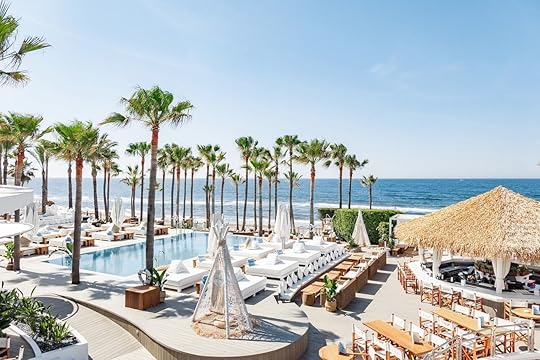
As travel becomes more accessible, many of us are considering a dreamy European holiday. And nothing says you’re on vacation quite like sipping on a spritz while lounging on a sunbed at a beach club. European beach clubs are luxurious and one of the finer ways to enjoy a day on the Mediterranean. These venues don’t mess around, they provide world-class service, exquisite food and drinks all with a backdrop of the ocean with a live DJ soundtrack.
What sets it apart from simply hanging at the beach, is comfort and convenience. If you love spending a sunny day lounging on a sunbed and partying into the night, then you definitely need to reserve a beach club on your next European trip. These clubs are some of the more exclusive venues in Europe, so before you make a reservation, here are a few things you need to know.
When to visit a beach club in Europe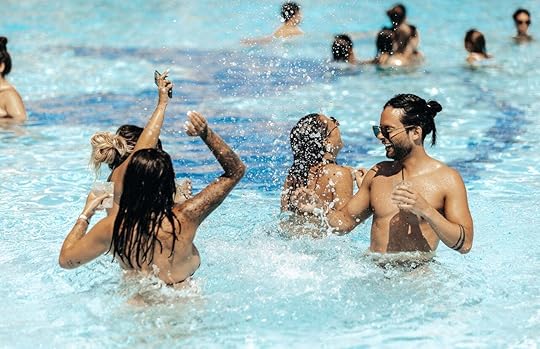
Photo: Ocean Club Marbella/Facebook
Seasons for each beach club vary, but generally, they are open from April through to October. Just like the destination, beach clubs also have a high season which is usually July until September. During this period we do advise that you reserve in advance, especially for the more popular ones. If not be prepared to arrive first thing in the morning and queue in order to get a decent spot.
How much do beach clubs in Europe cost?
Photo: Nammos Mykonos Bar/Facebook
As beach clubs are a luxury VIP experience, prices are not for the faint-hearted, but hey, it’s definitely worth it. Entry is based on the space you’re renting for the day, and some clubs have a minimum spend, which is pretty easy to hit with food and drinks. Food and drink prices are typical of high-end restaurants and clubs. As an indicator, expect to spend approximately $20 per cocktail or on basic dishes like a light sandwich.
The most common cost is a fixed charge for a sunbed or an area like a cabana. Beach clubs usually have several rows of sunbeds and cabanas, so you will need to pay a premium if you want to sit front row to the beach or pool. This gives you easy access to the water and the best views and seats in the house. Rates vary considerably depending on what beach club you go to, the season and even the day. The most expensive time is during the peak holiday months, especially on weekends.
What to expect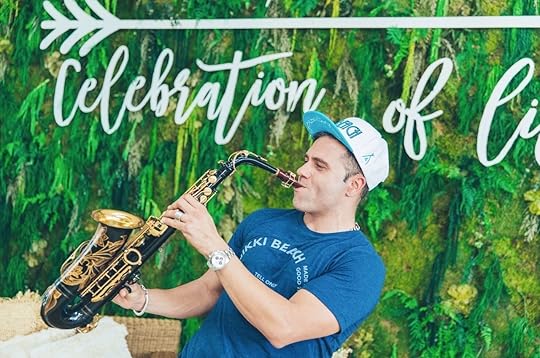
Photo: Nikki Beach Marbella/Facebook
Beach clubs are set up for you to leisurely soak up the sea, sand and sun all day. They provide everything from towels, toilets, showers, small changing rooms, bar area(s) and a restaurant. Depending on what you reserve, you usually don’t need to move at all — unless you want to — as staff will be constantly checking up on you to make sure you are set for food, cold drinks and anything else your heart (and budget) desires.
There usually is a resident DJ spinning during the day and into the evening. Many hold events featuring world-famous DJs so it’s worth looking at the club’s annual schedule. Note the dates will sell out quickly, especially in peak season. There are some clubs that lean on a more loungey chill vibe, so again it’s worth doing a little homework before you book to make sure you find a good fit before you financially commit. As mentioned, live music goes into the night, so prepare yourself for staying the long haul. Believe us, you won’t be in a huge rush to go home.
What to should you pack to a beach club
Photo: Ocean Club Marbella/Facebook
Since your visit can last past sunset, below are some essentials you should bring.
Sun protection like sunblock, hats, sunglasses, etc. Most clubs will have a small shop with these essentials — but be prepared to pay a premium price for them.A set of dry clothes so you don’t have to go back to your hotel before dinner or continuing the party. Most clubs will have showers, hairdryers and changing rooms so you can freshen up. Some clubs are even open until 2:00 AM so you can just change into your evening outfit and party into the night.Cash. While most places will accept credit cards, it’s good practice to have enough to pay for a taxi fare home, any extras you might need and to tip the servers.The best beach clubs in EuropeEach beach club has its own vibe — it really depends on what atmosphere, music and crowd you’re going for. Here are some of our favorite beach clubs in Europe.
Nammos, Mykonos, Greece
Photo: Nammos/Facebook
This club has been named one of the best beach clubs in the world by numerous luxury travel publications. Located at Psarou beach, there is a restaurant, bar, private cabana area and rows of sunbeds by the ocean. While their beach is on the smaller side, Nammos focuses on its exclusivity as the elite crowd and celebrities are usually spotted here. The concept behind Nammos was influenced by the superyachts parked in front of its beach with an atmosphere that is about as relaxed and luxurious as it gets. Sunbeds can cost as much as $175 during summer for front row spots, not including food or drink.
Scorpios, Mykonos, Greece
Photo: Scorpios Mykonos/Facebook
A more chilled version of Nammos, Scorpios is also one of the best in Mykonos and is part of the Soho House family. Its bohemian aesthetic overlooking the blue seas is perfect for a chilled chic day out. Located on Paraga beach, you get a beautiful view of the sunset, especially from its custom-built stage and open-air terraces. When the sun sets, bonfires are lit and the music is turned up. The club is extensive, spanning three areas from the western sunset lounge, beach and sunbed area, the eastern terraces and small beach to the restaurant, music lounge and bar at the heart of the venue. This is a place you’d likely never forget in your lifetime.
Ocean Club, Marbella, Spain
Photo: Ocean Club Marbella/Facebook
Known as one of Europe’s largest beach-side venues, this modern and stylish club focuses on partying — they even have a seasonal calendar for special events and guest DJs. Located next to Puerto Banús, Marbella’s famous marina, their sunbeds have views of the sea and access to their huge saltwater pool. With themed costumed dancers and energetic dance music, this place definitely attracts bigger group parties such as those on bachelor or bachelorettes.
Nikki Beach, Marbella, Spain
Photo: Nikki Beach Marbella/Facebook
Nikki Beach has multiple locations around the world and is known for its party scene. Resident and famous guest DJs play house music from the early afternoon before raising the tempo as night falls. The venue is divided into two areas: dining at the restaurant or lounging by the pool and beach club area. Dining at the restaurant unfortunately does not grant you access to the pool, so be sure to book the beach club if you want to have a swim. Booking the beach club gives you access to your allocated sunbed, prices differ for a beach or pool spot. The beach area is more loungey and chill, whereas the pool area has a party vibe, with many ordering countless bottles of champagne — which too often gets sprayed over the crowd.
Lido One Fire Beach, Praiano, Italy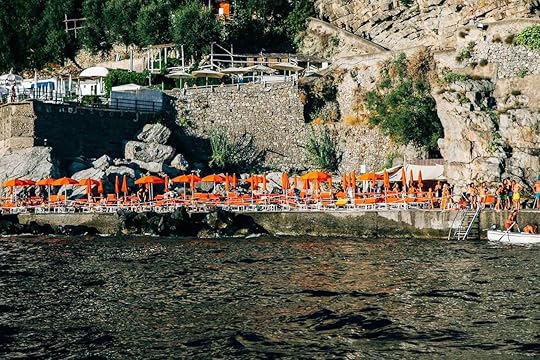
Photo: Lido One Fire Beach/Facebook
Beach clubs in Italy are called a ‘lido’ or ‘stabilimenti balneari’, which means “shore” or “bank” in Italian. What sets One Fire Beach apart is that this is a boat-in beach club. Only accessible by boat or a steep cliffside path, One Fire Beach is a private beach with cute orange sunbeds and umbrellas lined up on the edge of the sea. Renting lounge chairs cost approximately $25 per person and $6 if you need a towel.
Cavo Tago, Santorini, Italy
Photo: Cavo Tago/Facebook
Not a true beach club but this five-star boutique hotel does offer day passes to enjoy the sunbeds by their amazing infinity pool that overlooks Santorini’s caldera. They play chill lounge music and it’s a place to be seen and to see celebrities and the elite. To keep the place exclusive, daybeds are reserved first for hotel guests and the non-hotel guest price for sunbeds do come at a premium. For example, be prepared to pay around $240 for two guests for only two hours on a daybed. This includes two glasses of rosé and a plate of sharing tapas. 
The post How to slay at Europe’s hottest beach clubs, Nammos, Ocean Club, Nikki Beach appeared first on Matador Network.
How to have a more authentic Caribbean experience on Grand Cayman

An online image search for Grand Cayman suggests that the island’s tourism appeal is limited to swimming with the stingrays, cruise ships, and a single strip of sand that runs along the island’s western shoreline — Seven Mile Beach. While there is no doubt that the luxury high-rise hotels and fancy restaurants lining this beach are the main attraction for many tourists, more intrepid travelers find that a trip to the lesser-known eastern districts of East End and Northside offers a more authentic Caribbean experience. Free of the crowds and high prices of Seven Mile Beach, the outer reaches are a wonderful place to breathe and relax. Let’s discover the real Grand Cayman through the eyes of the locals.
BeachesThe districts of East End and Northside have stunning beaches without an overpriced sun-lounger or jet ski in sight. The beaches are often hidden from the road by trees and vegetation or sheltered among the rocky cliffs of the rugged coastline. The key to finding them is to look for the brown roadside signs that lead you down narrow paths through the bushes. Simply park your car on the verge and bring your sunscreen and a hat. Here are three locals’ favorite beaches on Grand Cayman.
Barefoot Beach, East End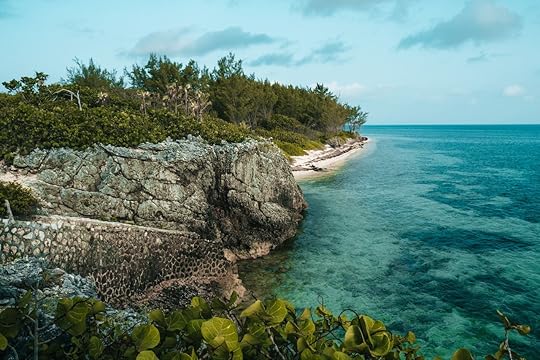
Photo: Tanner Manning/Shutterstock
Located on the Queen’s Highway, a road that runs along the island’s Northside, Barefoot Beach is a serene spot that faces the prevailing northerly trade winds creating a cool and breezy place to relax. The numerous pine trees offer plenty of shade and there is nothing better than stringing a hammock between two trees, setting a cooler of drinks below you, and whiling away the day with a good book. Parking here has become more difficult recently as the narrow path has been washed out and is no longer vehicle accessible, so find a safe spot along the roadside and walk down instead.
Heritage Public Beach, East End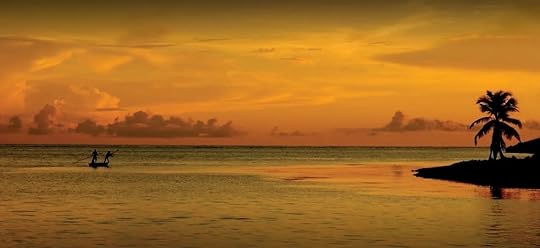
Photo: Visit Cayman Islands
This is a government-managed public beach, so it is clean and well-maintained. It has a shady cabana and tall trees to hide from the sun. It is located in an area surrounded by a natural fringing reef that protects the shoreline from large waves. Even in windy weather, the waters here are calm and great for paddle boarding and snorkeling. Look for large spotted eagle rays which glide gracefully through the shallow lagoon searching for food, especially at dawn and dusk.
Colliers Public Beach, East End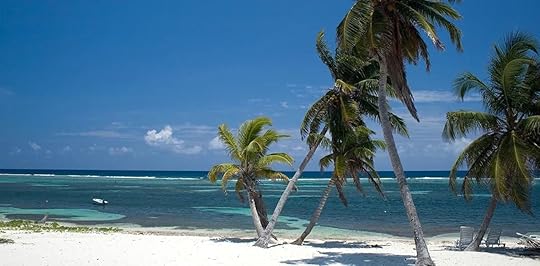
Photo: Visit Cayman Islands
Situated at the north-eastern corner of the island, Colliers beach is a wide-open expanse of powdery sand complete with colorful cabanas and public amenities such as restrooms and showers are provided free to the public. There are even grills, picnic benches, and trash cans that visitors are welcome to use making it a great spot to have a BBQ lunch. A small convenience store is located just a mile down the road to pick up supplies.
ActivitiesAs you might imagine, activity options in the eastern districts center around the ocean. However, there are still plenty of things to do on those days where you do not want to get wet. Nature lovers especially will be in heaven with a multitude of options.
SCUBA diving and snorkeling
Photo: Ocean Frontiers Boat Diving/Facebook
Diving in the Cayman Islands is already known as world-class, but diving on the East End takes this to a whole new level. With only two dive operators, Ocean Frontiers and Tortuga Divers, and over fifty named dive sites, it feels very uncrowded. Significantly fewer environmental pressures compared with the densely populated west side means healthier reefs and abundant marine life. The local resident divers know this, and you can expect to share the boat with them on the weekends as they flock east to enjoy the best diving on the island.
The Cayman Islands are formed by the protruding tops of a submerged mountain range so they are surrounded on all sides by a steep underwater drop-off. Most dive trips start with an adrenaline-inducing deep dive along the phenomenal shear wall, followed by a serene shallow reef dive to relax and enjoy the warm water and amazing clarity. Expect to see sharks, rays, eels, and all the usual reef fish too. The two local dive operators offer entry-level programs through to more advanced courses and daily dive trips for all levels.
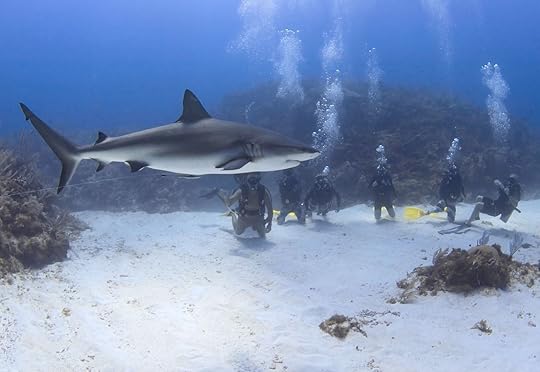
Photo: Ocean Frontiers Boat Diving/Facebook
For snorkelers, shore entries are possible but undeniably more limited than on the west side due to the breaking waves and fringing reefs. However, those who want to see the best corals and marine life on the island should fork out around US$50 for a boat trip taking in the best snorkeling the area has to offer with knowledgeable guides and stringent safety procedures.
Kiteboarding and paddle boarding
Photo: Sven Hansche/Shutterstock
The fringing reefs around the eastern coastline not only offer a calm haven for marine life, but also the ideal conditions for people to enjoy being on the ocean too. The near-constant onshore winds in the winter are a kiteboarder’s dream, and between November and April, you can expect the sky to be full of brightly colored kites dancing in the air. If you have your own gear then launching from any of the public beaches is easy and perfectly legal, while beginners can contact a local kite school for high-quality instruction, gear rental, and support. The area around Collier’s Bay in the northeast is the most well-known location for kiting and is where the kiteboarding schools are located.
For those seeking a gentler way to spend the day, the surface of the water remains calm enough for paddle boarding thanks to the protection from the barrier reefs. Easy to learn and extremely fun, paddle boarding is also very good for your health and fitness, not to mention a great mental break from social media and emails. Experienced paddle boarders can travel for miles around numerous and vast protected areas, while beginners can stay near the beach while they get their balance. Remember, falling in the water is half the fun. Paddle boards can be rented from most of the hotels, and many Airbnbs have them available for guest use. Also, there are paddle board rental companies that offer island-wide delivery and pick-up.
Queen Elizabeth II Botanic Park
Photo: Queen Elizabeth II Botanic Park
The beautifully landscaped and well-tended Queen Elizabeth II Botanic Park sits in the island’s interior, accessible via Frank Sound Road. The site sprawls across many acres and offers visitors a tranquil refuge. A soothing stroll along wooden boardwalks learning about endemic plant and animal species can calm even the busiest mind, while the extensive woodland trails will exercise the body too.
Highlights of the park include the orchid trail, the color gardens full of exotic flowers, the serene lake, and the blue iguana reserve. Blue iguanas are endemic to the Cayman Islands and are a protected species due to the many threats that they face, not least of all from the invasive green iguana. Entry is only $10 and it is easy to spend at least half a day enjoying everything the park has to offer.
Crystal Caves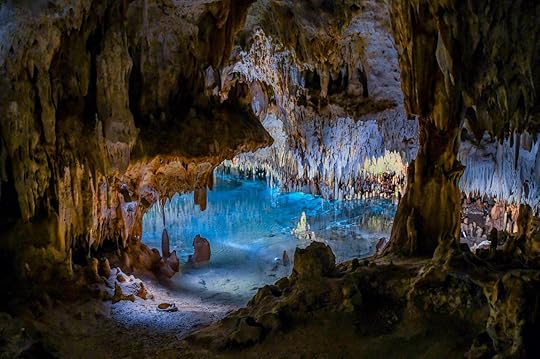
Photo: Katie Thorpe/Shutterstock
There is no better place to escape the sun than underground. Located in Northside, the Cayman Crystal Caves offer tours by local guides who show you not only the beautiful caves themselves but also the surrounding forest. The friendly guides are bristling with plenty of interesting information about the local flora and fauna, as well as some history and culture too. Although perhaps not as extensive as cave systems in other parts of the world, this fun attraction nonetheless provides a great way to spend half a day when all that time at the beach has become too much.
Accomodation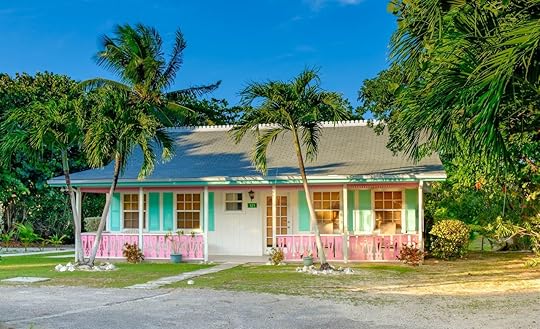
Photo: Eric Laudonien/Shutterstock
Grand Cayman has experienced the Airbnb revolution just like everywhere else in the world and offers visitors to the eastern districts a wonderful opportunity to experience real Caribbean living. Unlike the faceless mega-resorts of the west, the east end is full of cozy and modest beachside properties while still providing all the modern comforts such as AC and WIFI. Where to base yourself is a matter of personal choice, but let’s look at some options below.
East End VillageWith a population of 1200 people, the village of East End is where the main amenities are located such as a gas station, post office, and an ATM. Some good deals can be had here if you are happy to be away from the oceanside on one of the backstreets. However, with limited access to the sea, lots of passing cars, and noisy neighbors, many choose to base their vacation in a quieter area.
Gun Bay and Austin Connelly DriveAustin Connelly Drive begins just north of the village leading through an area known as Gun Bay before ending in Colliers Bay where it becomes the Queen’s Highway. This three-mile-long stretch of road has plenty of great accommodation options which are still close to all the attractions yet offer a peaceful getaway with easy ocean access. The only resort in the area is Compass Point which is small, friendly, and a great choice for divers and their families. Plenty of modestly sized and cute private homes are available to rent in this area as well, the vast majority of which are right on the ocean. Great for people who love epic sunrises.
Queen’s HighwayFor those with money to burn, a taste for unadulterated luxury, or a large group, the massive villas that line the Queen’s Highway along the island’s northern coastline are where you want to be. Many of these homes are nothing short of palatial and have everything that one would expect when paying for such luxury. Secluded and hidden from the highway by high walls, wrought iron gates, and thick hedges, these offer guests the highest level of privacy. Much of Queen’s Highway runs along the top of a rocky bluff, but most of the homes have stairs leading down to tiny private beaches hidden in sheltered coves.
Cayman KaiAt the far western edge of Northside, Cayman Kai is a trendy and exclusive neighborhood that offers many types of accommodation ranging from small wooden homes to contemporary architectural works of art. There is no through-road so it is a quiet and undisturbed area that really feels like you are away from it all. There are a couple of local bars and restaurants as well as a small convenience store but don’t expect to have lots of options close by. Although the remoteness and beauty of Cayman Kai is in many ways a major selling point, some folks may be put off by a long drive to other parts of the island including grocery stores and a larger selection of places to eat and things to do.
Bars and restaurantsEnjoying cold drinks while listening to lapping waves is a Caribbean institution, and Grand Cayman is no exception. The eastern districts have plenty to offer in this department with the added bonus of lower prices and fewer crowds. The island’s strong international reputation means a high level of food safety and quality, and a range of drinks options to suit everybody. Here are some of the most popular bar and restaurant options in the outer districts.
Kaibo Beach Bar, Northside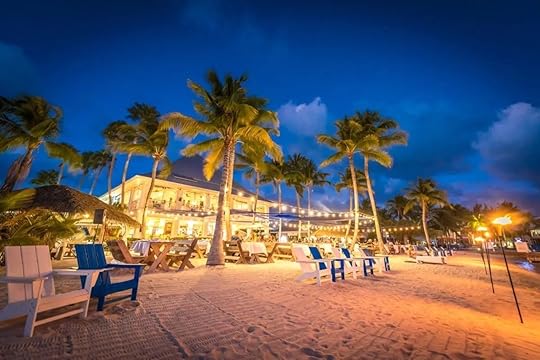
Photo: Kaibo Bar
Many have heard of the infamous Rum Point Bar, but savvy drinkers know that Kaibo Beach Bar just a mile to the south offers a more relaxed experience without the boats full of day-trippers. With a stone pizza oven, cold brew coffee, and a toes-in-the-sand dining experience, Kaibo is a fantastic place to get away from it all. In the evenings the area is illuminated with subtle lighting and gentle live music which completes the soporific atmosphere.
Over The Edge Cafe, NorthsideWith a deck extending out over the water, low ceilings, and a tasteful nautical theme, Over the Edge Cafe is a spot that is very popular with both tourists and locals that has an honest feel without being pretentious. While its rustic vibe may not appeal to everyone, this charming bar has many fans who return year after year. Those who like to eat real Caribbean cooking will love the menu options here, while picky eaters and young ones will be satisfied by the American-style options too. A real highlight is their breakfast menu filled with exotic-sounding dishes such as Saltfish and Ackee — a Jamaican delicacy consisting of salted fish and the cooked flesh of ackee, a sweet fruit native to the Caribbean.
Eastern Star Bar, East EndNewcomers may be surprised by this bar’s unexpected location behind a gas station, but a small wooden walkway down the side leads to a lovely beach area lined with picnic tables and an outdoor bar and kitchen. On Sundays, the place is full of local families listening to loud soca music and enjoying freshly cooked fish. Eastern Star Bar, while very welcoming of tourists, is certainly not a tourist bar — don’t expect the same level of service that you might expect back home. But go in with the right attitude and you will see the true friendliness of the Caymanians.
Blue Rock, East End
Photo: Blue Rock Bar
If you find yourself tired of beach bars and sunshine and are in need of some chilled AC and dim lighting, then look no further than Blue Rock Bar, located in a small plaza within the Health City complex on the south side of the island adjacent to Lovers’ Wall. Offering pool tables, televisions, and comfortable seating, Blue Rock is a popular choice to escape the tropical heat outside. The friendly staff loves to mix up a variety of cocktails with real ingredients, and the chefs put out consistently good food of all styles. The Indian options are arguably the best, and the Biryani of the day is incredible. 
The post How to have a more authentic Caribbean experience on Grand Cayman appeared first on Matador Network.
August 26, 2021
The 10 most expensive cities for airport car rentals in the US
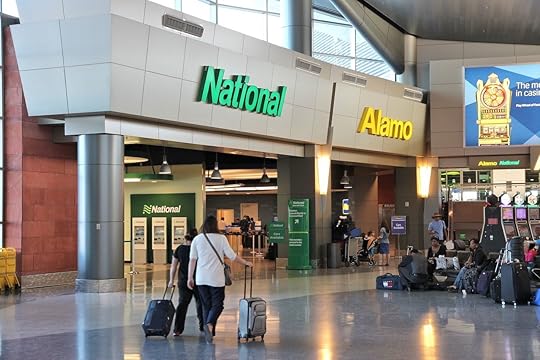
Rental cars have been hard to come by this summer as the US experienced a shortage. And with a low supply and a very high demand, the prices of car rentals have skyrocketed. CheapCarRental, a website that allows prospective renters to compare prices between car rental companies, has noted that “rental car rates across the United States are, on average, about 50% higher now than last year, looking at rates from August 2020. In certain cities, including Minneapolis, Seattle and Boston, average rates have doubled year over year.”
To make sure future renters plan their vacation with all the necessary information at their disposal, CheapCarRental conducted a survey that compared airport car rentals rates at the top 100 US airports.
Anchorage, AK, leads the top 10 with an eye-watering average weekly rate of $1451. The top 10 ranking includes four cities in Hawaii.
The 10 most expensive cities for airport car rentals in the US:
(Prices are average weekly rates — from Sunday to Saturday — for the most affordable rental cars, August 1-31, 2021.)
If you want to know if your next vacation destination is one of the top 100 most expensive cities for airport car rentals in the US, check out CheapCarRental’s full ranking.
And if renting a car proves too pricey, check out Matador Network‘s guide to the best car rental alternatives for cheaper options. 
The post The 10 most expensive cities for airport car rentals in the US appeared first on Matador Network.
European travel requirements seemed dauntingly strict. Turns out I was overprepared.
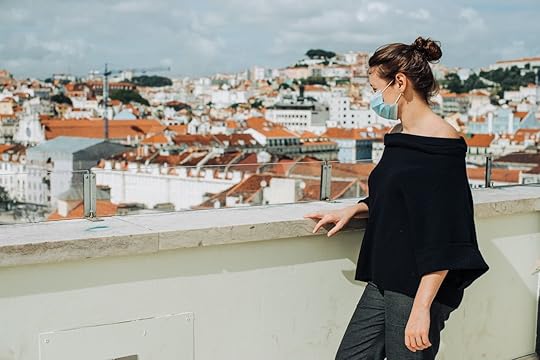
In early August, as I was packing my carry-on for a month-long trip to Europe, I was sure I had everything in order for my first international flight since the start of the pandemic. I’d triple-checked the requirements for entering Portugal, where the emergence of the Delta variant had complicated an already fickle travel landscape. I slipped my CDC-issued vaccination card and the negative results of a rapid antigen test taken within 48 hours of my departure into the sleeve of my passport case, completed the passenger locator form issued by the Portuguese government, and dug up an unopened N95 face mask to wear on the plane.
Confident as I was that I’d met all the travel requirements, the nagging fear that I’d missed a step that would prohibit me from boarding my flight crept into mind as I pulled up to San Francisco International Airport. The one scenario I hadn’t considered was that I might have been overprepared.
Expectations versus reality: Flying into and traveling around EuropeWhen I arrived at my gate, I was asked to sign a statement declaring that I wasn’t experiencing any coronavirus symptoms before entering France, as I would be flying to Lisbon via Paris. Though the form stated that it was to be presented before boarding and again at border control at Charles de Gaulle, I wasn’t asked to flash it or my vaccination card when I arrived. After verbally confirming that I was vaccinated, I was waved through to catch my connection, where the gate agent asked for my vaccination card but not my negative rapid antigen test.
France, unlike Portugal, doesn’t currently require fully vaccinated American travelers to have proof of a negative coronavirus test. Because France was where I entered the European Union, I wasn’t asked to show my negative test results at any point in my outbound travels, nor was the QR code generated by my completed passenger locator form ever scanned.
I was required to produce a negative test to leave Lisbon, however. A few weeks after landing in Portugal, I packed my bags for Montenegro. I flew into Dubrovnik, Croatia, via Amsterdam, rented a car at the airport, and followed the coast south. My vaccination card was requested as proof of health at passport control in both Amsterdam and Dubrovnik, as advertised (either a vaccination card or a negative rapid antigen test is required to enter Croatia). Finding information on the requirements to cross the Montenegrin border by car was more difficult. In the end, my passport was the only documentation needed.
Suffice it to say, the reality of my European travels has not matched my expectations. To complicate matters more, the requirements that were enforced when I was in transit were not the same as those that my part-time travel companions experienced.
A few weeks after I arrived in Lisbon, my friend Peter came to visit. He flew direct from Raleigh, North Carolina, on the Portuguese airline TAP and was required to provide proof of a negative coronavirus test upon arrival, although a second test was not required for him to continue on to Spain the following. The friends he met in Barcelona that had come directly from the United States didn’t need a negative test, either.
My friend Karin, who I met at Amsterdam Schiphol mid-month, got tested before her departure from San Francisco. Unlike me, Karin was asked to show both a negative test and her vaccination card at the check-in and baggage counter in San Francisco, where I hadn’t stopped because I checked in online and only brought carry-on luggage. She didn’t have to clear passport control in Amsterdam to make our connecting flight to Dubrovnik as I had, and once in Croatia she was similarly asked to flash her vaccination card. Her health declaration form issued by the Dutch government was never collected.
Expectations versus reality: Health and safety measures in Europe
Photo: Elizaveta Galitckaia/Shutterstock
Transit procedures aren’t the only question mark of pandemic-era travel. What to expect on the ground is another consideration, from what the local rules are to how they’re enforced.
In Lisbon, everything I’d read suggested that some people would wear masks outdoors while others wouldn’t, but that masks would be required indoors. This proved to be true. About half of the people I passed on crowded city streets wore masks. From what I could gather, the majority of those who didn’t were tourists.
Masks were also standard in every store I visited. Though I only ate inside at a handful of restaurants, each had its own entry requirements. Most asked for proof of vaccination, though on one occasion the confirmation email from my testing site in California was accepted as verification, while a covered terrace only asked for verbal testimony and a temperature check to dine. Elsewhere, such as the lone bar I patronized, didn’t ask for proof of vaccination.
Testing and proof of vaccination requirements at accommodations were perhaps the biggest surprise I encountered in Portugal. I had read that Airbnb hosts were supposed to confirm that guests had been tested, or direct them to get a fresh test altogether, but mine coordinated self-check-in and asked for no such evidence. In another example, the hotel that Peter and I booked for a weekend trip to Ericeira, a surf town roughly 45 minutes north of Lisbon, had warned us that we would need to show a negative test on arrival. When we got there, vaccination cards were requested instead.
In Montenegro, which the CDC recently classified as a very high-risk destination, masks are uncommon. Aside from our hotel staff and grocery store employees and shoppers, Karin and I were among the only mask-wearers we saw anywhere, indoors or otherwise, from our hotel’s breakfast buffet to the beach. Hand sanitizing stations, on the other hand, are ubiquitous.
What to expect when you’ve arrived at your destination will depend entirely on where you’re traveling. It’s a good idea to err on the side of caution when you’re planning and packing, particularly given how quickly travel rules and restrictions can change.
If you have one, bring your vaccination card, but also take a picture on your phone as a backup or digital alternative. Pack multiple masks. Consider purchasing a few at-home coronavirus tests before your departure, or check if they’re available over the counter in your destination. In Portugal, for example, pharmacies sell at-home test kits for roughly two euros, a fraction of what Peter paid for the tests he brought from California, just in case. Though these tests are not suitable for air travel, they may suffice should an accommodation or indoor venue require you to show proof that you’ve recently tested negative. The tests will also provide peace of mind if you exhibit any symptoms and are concerned about spreading the virus.
Expectations versus reality: Getting a coronavirus test in EuropeSo far, the ease of scheduling last-minute coronavirus tests has been a pleasant surprise throughout my European travels. I’d heard horror stories about travelers in Portugal scrambling to make an appointment. Though the first pharmacy in downtown Lisbon that I called prior to my flight to Dubrovnik did not have any availability for four days, the pharmacy in the Martim Moniz neighborhood that I phoned next accepted walk-ins. A rapid antigen test cost 25 euros, there was no one in line when I arrived, and I had my negative results within 10 minutes.
In Montenegro, my Airbnb host confirmed that testing centers are easily accessible in the resort town of Tivat, my final destination, as well as in Dubrovnik farther up the Adriatic coast. Compared to the trouble I faced securing an appointment to get tested in the Bay Area earlier that month, which can cost 10 times as much for anyone without a health insurance plan that covers elective coronavirus tests, my experience getting tested in Europe has been a breeze — and an affordable one at that. 
The post European travel requirements seemed dauntingly strict. Turns out I was overprepared. appeared first on Matador Network.
These New York City hotels offer great rates and stunning skyline views
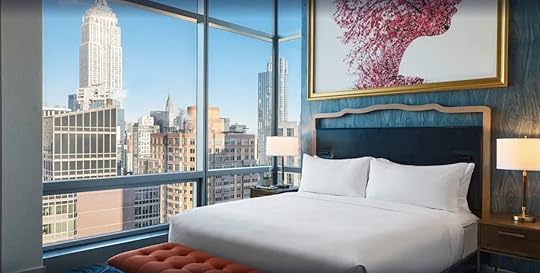
New York’s Manhattan skyline is the most iconic in the world. But with over 700 hotels to choose from, it can be difficult to know the best place to stay to enjoy the showstopping views of the city, especially from the comfort of your own bedroom. Here is a selection of the most stunning NYC hotels with skyline views.
We hope you love the spaces and stays we recommend! Just so you know, Matador may collect a small commission from the links on this page if you decide to book a stay. Listed prices are accurate as of the time of publication. See our full Advertiser Disclosure here.
Mandarin Oriental
Photo: Expedia
Upon entering the Mandarin Oriental’s 35th floor Sky Lobby, guests are greeted by artist Dale Chihuly’s magnificent crystal sculpture that sets the tone for one of New York’s most sophisticated and thoughtfully designed hotels. The Mandarin Oriental’s distinctive design elements and artworks pay homage to its Asian inspiration and are guided by the principles of legendary Master Feng Shui, who has created a harmonious space well removed from the hustle and bustle of the metropolis below. The Asiate restaurant serves up a taste of the East alongside unrivaled panoramas of Central Park, and each of the hotel’s lavishly decorated suites offer views either of Central Park or the Hudson River. For a unique East Side meets West Side perspective, consider the outrageous Suite 5000. This 3,300 square feet space on the 50th floor offers wrap-around views of the city, three bedrooms, a living area, a media room, and a walk-in wardrobe. Yours for the night for a cool $36,000.
80 Columbus Circle, Manhattan
Price: From $716

Photo: Expedia
The Renaissance pitches itself as a lifestyle hotel for a younger demographic who want a quirkier experience than what’s offered at most hotel chains. This is epitomized in the funky wall decoration that climbs from the lobby to the first floor of the Renaissance New York Chelsea — a massive art installation made up of hundreds of mounted antiques — a nod to the hotel’s former life as the home of the Antiques Garage flea market. This has become Chelsea’s most popular NYC hotel with skyline views. At the top of the hotel, spread over the 38th and 39th floors, is Somewhere Nowhere, a garden lounge and open-air rooftop pool run by the El Grupo SN nightlife company, which plays host to some of the hippest (and highest) parties in New York. For partygoers looking out from the rooftop pool it can feel like winning at a game of sightseeing bingo. The East River, Brooklyn Bridge, the top of Madison Square and, looming large in the foreground, the gargantuan Empire State building provide the perfect backdrop for a night out in the city that never sleeps.
112 W. 25th Street, Manhattan
Price: From $161
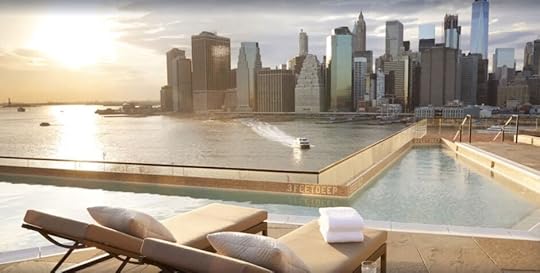
Photo: Expedia
For the forward-thinking, environmentally conscious traveler with a weakness for lavish living, the 1 Hotel Brooklyn Bridge is undoubtedly the benchmark for sustainable luxury in New York City. Inspired by nature and with an explicit pledge to lead the conversation on sustainability, the hotel’s green credentials are conspicuous in the little details, from the recycled rainwater water system to its’ no-plastics policy and the furniture crafted with reclaimed wood from old New York water towers. These elements lend an earthy, natural character to the hotel and its guestrooms, which one could easily mistake for an exquisite wilderness cabin were it not for the exceptional views through the window of the Brooklyn Bridge or the Statue of Liberty. The views of the Lower Manhattan skyline across the East River from the rooftop pool deck and plunge pool, use of which is exclusive for hotel guests, are unparalleled.
60 Furman Street, Brooklyn
Price: From $366 per night
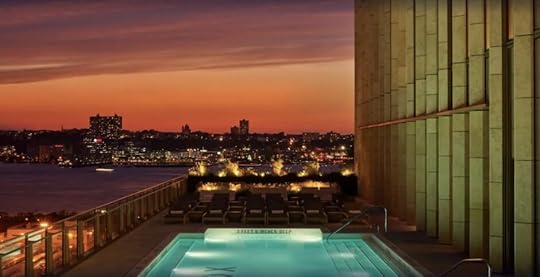
Photo: Expedia
When the pandemic prompted leading names in the hospitality industry to pivot towards a guest experience that prioritizes health and well-being, the Equinox at Hudson Yards saw no need. They were already well ahead of the game. This sleek, modern entry into the New York luxury hotel scene guarantees that guests will leave a little bit better off than when they arrived, with rooms specifically designed to restore and revive courtesy of a plethora of details including spring-free beds infused with temperature-regulating natural fibers, state-of-the-art soundproofing technologies, and AC units fitted with optimum medical-grade filters. The best views are from the rooftop pool and, of course, the signature fitness center — probably the largest hotel gym in the world — where your bench press or treadmill overlooks the River Hudson and Manhattan’s West Side skyline. For even more spectacular vistas, take a trip to the Edge. The Western Hemisphere’s highest outdoor sky deck is located on the Equinox’s doorstep, and stepping out onto its glass floor suspended 100 stories in the air will delight and terrify in equal measure.
33 Hudson Yards, Manhattan
Price: From $700
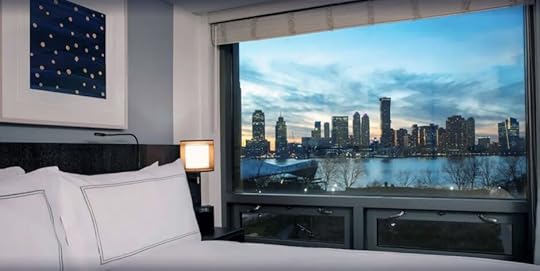
Photo: Expedia
The Conrad New York Downtown’s commitment to delivering strong visuals is evident from the moment you step into the atrium. Legendary artist Sol LeWitt’s Loopy Doopy (Blue and Purple), a striking painting that looms ten stories high, is the crowning jewel in the hotel’s extensive contemporary art collection that numbers some 2,000 works across its public areas and 463 suites. All the suites have been refurbished during the pandemic, so expect to find sleek, stylish interiors in every room. For the hotel’s signature views of the New York Harbor, opt for a Hudson River Suite. In the evening, drink in the iconic sight of the Statue of Liberty standing guard over the River Hudson with a cocktail at the distinguished Loopy Doopy rooftop bar, whose name, borrowed from the artwork downstairs, embodies the hotel’s unique positioning as an art-led experience.
102 North End Eve, Manhattan
Price: From $262

Photo: Expedia
Once considered the bohemian heartbeat of Brooklyn, gentrification in the former manufacturing neighborhood of Williamsburg has given it a more polished edge in recent years. Its vintage shops, contemporary street art, and lively indie music scene are all a testament to the creative energy that endures today, however. The Williamsburg Hotel taps into the neighborhood’s storied past with its industrial steel and red-brick facade belying its Art-Deco approach to interior designs. A classy hipster vibe permeates through the property. The highlight here is the swanky rooftop pool and lounge, which offers al fresco dining, top-drawer cocktails, and unobstructed views of Manhattan across the East River unmatched anywhere in Williamsburg. The rooms have floor-to-ceiling windows that bathe the space in natural light but be sure to go for a terrace room if you want your own balcony from which to take advantage of the views of either Brooklyn or the New York skyline.
96 Wythe Avenue, Brooklyn
Price: From $203

Photo: Expedia
In the luxury hotel world, The Peninsula name is synonymous with quality. No other hotel group has been awarded Five-Star status by Forbes across all its locations. The Peninsula New York is another leading example of high-end service at its finest. With its Beaux Arts-style architectural style, primly garbed door staff, and limousine service, The Peninsula exudes all the trappings of classic New York while in the guestrooms and suites, the modern trimmings and surprising roominess give the impression of luxurious apartments. Escape the grip of the city with a few lengths of the tranquil glass-enclosed pool, then step out onto the sun terrace and soak up the views of Fifth Avenue. Meanwhile, the outstanding spa on the 21st floor is widely regarded as the best in the city (and with ten treatment rooms it’s certainly the biggest). But for all The Peninsula’s character and amenities, it’s the exceptional customer service and the attention to detail from the staff that keeps guests returning in droves.
700 5th Avenue, Manhattan
Price: From $701
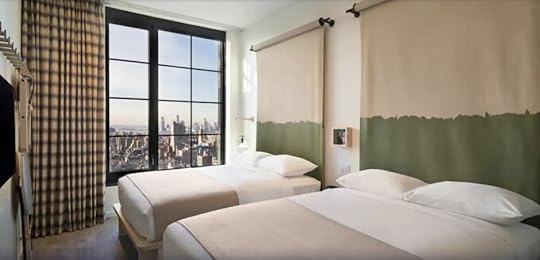
Photo: Expedia
The Moxy NYC Chelsea is tucked away in Manhattan’s Flower District on the best-smelling block in NYC. True to the Moxy brand, the hotel draws on the neighborhood’s local heritage with a floral theme that runs throughout its interior design from the magnificent flower shop you pass through to reach the lobby to the falling rose petal wallpaper in the bathrooms. The rooms themselves have been crafted with the millennial Instagrammer in mind; light, natural tones are complemented by the characterful industrial furnishings that speak to the Moxy’s fun and spirited values, and the floor-to-ceiling windows offer stunning views of the city from your bed. On the 35th floor, the rooftop cocktail lounge boasts one of the only 360° views in Manhattan and brings you up close and personal with that most iconic of fixtures on the New York skyline — the Empire State building. 
105 W. 28th Street, Manhattan
Price: From $199
The post These New York City hotels offer great rates and stunning skyline views appeared first on Matador Network.
Venice will soon make you book your visit and pay an entry fee
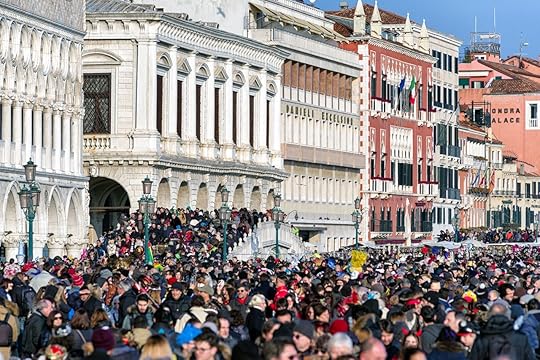
Venice is set to impose a new policy that will go into effect next summer. To act against overtourism, the city will soon require travelers to book their visit in advance and pay an entry fee.
In a report by Italian newspaper La Stampa, tourists on a day trip to Venice will have to pay an entry fee between between $3.50 and $12 depending on the season and enter the city via electronic turnstiles.
Lawmakers just approved the package of restrictions last week. These restrictions were set to take effect earlier but have been postponed due to the pandemic, CNBC explains.
Those visiting Venice during the peak season will have to book reservations early as the city will have strict capacity limits.
Residents or their relatives, children under six, and those staying in local hotels will be exempt from these restrictions. It remains unclear if Venice’s Airbnbs will be classified as local hotels.
This summer, all large cruise ships were banned from Venice. As reported by Matador Network‘s Eben Diskin in July, “all ships weighing over 25,000 tons are prohibited from entering the shallow Giudecca Canal that flows past Piazza San Marco. Only small passenger ferries and goods vessels will be allowed to use the canal. Residents have long advocated for the government to ban large ships from the lagoon, due to their pollution, ill effects on the ecosystem, and even accidents that have injured tourists.” 
A version of this article was previously published on July 30, 2020 and was updated on August 26, 2021, with more information.
More like thisNewsItaly finally bans all cruise ships in Venice, for real this timeThe post Venice will soon make you book your visit and pay an entry fee appeared first on Matador Network.
7 coolest wildlife crossings around the world
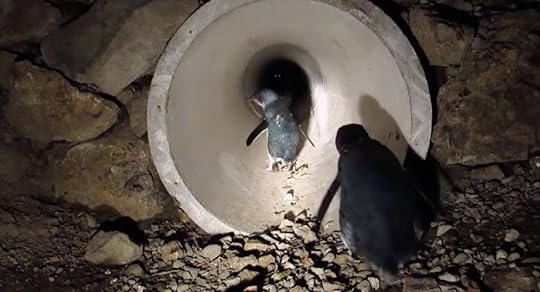
It might be an unfortunate reality, but animals have to adapt to us more than we do to them. We’ve got the tools, we build the roads, we drive the bulldozers. As we continue our relentless encroachment on animal habitats, we force our feral neighbors into unsafe living conditions, often bordering busy highways and other roads. As highways often bisect delicate ecosystems, the animals living there find themselves separated and isolated, endangering the ones that try to cross over.
To solve this problem, wildlife crossings are being built across highways all over the world. No, I’m not talking about the classic N64 game. Wildlife crossings are bridges or overpasses that extend over highways, allowing wildlife to cross safely. Often intended to blend into the natural environment, the crossings tend to be pretty creatively designed. From the Netherlands to Australia, these are the coolest wildlife crossings in the world.
1. Banff Wildlife Overpass, Canada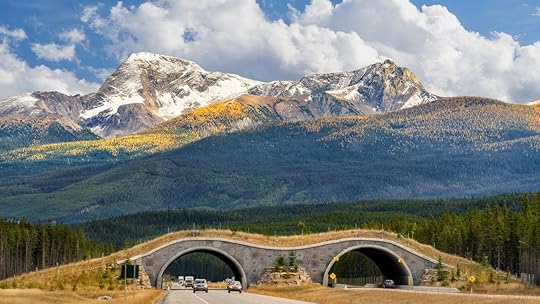
Photo: Craig Zerbe/Shutterstock
Banff has been leading the charge in giving animals safe highway passage for over 20 year. The national park, famed for its abundance of wildlife, has built several crossings for the benefit of its native wildlife. There are over six overpasses and 38 underpasses throughout the Trans-Canada Highway, reducing wildlife collisions by 80 percent and making Banff a major success story in the world of animal crossings. Defined by their semi-circular design, and paths lined with flora and greenery, these trailblazing crossings blend seamlessly into the natural environment. And set against the backdrop of Banff’s dramatic peaks, the crossings are arguably an attraction in themselves.
2. Crab Bridge, AustraliaVoir cette publication sur InstagramUne publication partagée par Christmas Island Tourism (@christmasisland)
Christmas Island, far off the northwest coast of Australia, isn’t known for its reindeer and elves, but for its abundant red crab population. Each year 50 million crabs dash toward the sea to spawn, though that annual migration has been disrupted by human infrastructure projects. To apologize for inconveniencing the crabs, and help them reach the sea, the island built a 16-foot-high bridge the crabs can use to cross the road. There have also been 65 miles of plastic barriers and thirty-one crab underpasses installed throughout the island to further assist the crabs on their journey.
3. Blue Penguin Underpass, New Zealand
Photo: Oamaru Blue Penguin Colony/Facebook
Not all wildlife crossings exist aboveground. One of the coolest actually takes the form of a tunnel, and probably not for an animal you’d expect. The town of Omaru on New Zealand’s South Island built an underpass for its korora penguins (little penguins). The korora penguin population is in decline, so the community is doing what it can to make their lives a bit easier. Since the penguins fish at sea but nest on land, the underpass makes it easier for them to travel back and forth underneath the road without endangering themselves in traffic. The underpass has been hugely popular in the penguin community, with an estimated 20 penguins making use of it each night.
4. Elephant Underpass, Kenya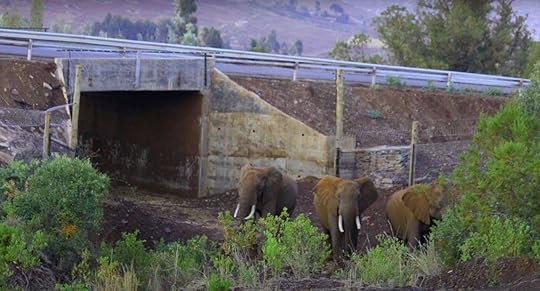
Photo: Lewa Wildlife Conservancy/youtube
Some of Africa’s wildlife are probably too tall for an underpass (we’re looking at you, giraffes), but elephants can greatly benefit from a well-placed crossing and aren’t quite tall enough to hit their heads. Africa’s first elephant underpass opened in 2011 near Mount Kenya, uniting two elephant populations that had been separated by human development. The underpass crosses under a regional highway, allowing elephants to travel safely from one side to the other. The importance of this simple piece of infrastructure can’t be overstated, as it allows elephants to reestablish connectivity with their brethren and reduce habitat pressure within the Lewa area. You can watch the whole process in this video from the Lewa Wildlife Conservancy.
5. A556 Green Bridge, United Kingdom
Photo: Gov.UK
Wildlife overpasses in the UK are called “green bridges,” and this one certainly lives up to its name. One of the most notable is the bridge that opened in 2018 above the Knutsford-Bowdon bypass on the A556 in Cheshire. The bridge is covered in greenery, which is intended to attract small animals like voles and badgers, drawing them away from the dangerous road. This crossing is also open to people, so if you feel like a relaxing jaunt across a multi-lane highway, you can help yourself.
6. Nutty Narrows Bridge, United States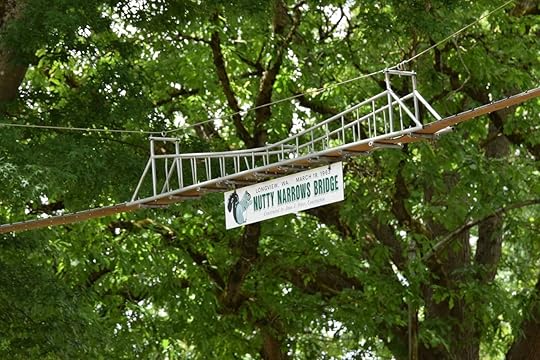
Photo: Paul Juser/Shutterstock
The Nutty Narrows bridge in Longview, Washington truly lives up to its name. It’s narrow, and has probably helped transport thousands of nuts during its nearly 60-year lifespan. Stretching high above a busy thoroughfare, the bridge was built to help squirrels safely cross from tree to tree without endangering themselves on the road. It’s construction set an important precedent in Longview, with several similar squirrel bridges being built around the community in the years since.
7. Natuurbrug Zanderij Crailoo, Netherlands
Photo: Pics-xl/Shutterstock
Wildlife in the Netherlands has the privilege of being able to stroll across the longest wildlife crossing in the world. Natuurbrug Zanderij Crailoo, which translates to “sand quarry natural bridge,” is 2,625 feet long and 164 feet wide, crossing roads, railways, and even a sports complex. It often plays host to deer, wild boar, and European badgers. 
The post 7 coolest wildlife crossings around the world appeared first on Matador Network.
From barbecue to sushi, Galveston’s restaurant scene rivals its legendary beaches

Walking into Maceo’s Spice and Import Co. on Galveston Island is a trip through time. Community tables are scrunched among grocery racks filled with house-made spices and sauces for sale. Black-and-white photographs crowd the walls, along with visual non sequiturs: a full-sized bicycle, a collection of surfboards, a tiny statue of Santa wearing a Hawaiian shirt. A refrigerated display is chock-full of specialty cheeses and meats, and the lunch counter’s fist-sized meatballs drenched with tomato gravy taste like they were directly imported from a Sicilian grandmother’s kitchen. Maceo’s is one among many Galveston restaurants that gets overlooked in favor of the city’s reputation as a beach getaway.
For five generations now, the Maceo family has built its legacy this little island off Texas’s Gulf Coast. First arriving in Galveston in the 1900s with a wave of immigrants from all corners of the world (Galveston in that era rivaled Ellis Island as an immigration port), the Maceos hosted 1940s A-list celebs on the island with a legendary underground casino and lounge known as the Balinese Room. Only occasionally would they run afoul of the Texas Rangers.
“Galveston was founded as an international port of commerce from the very beginning. So from our very inception, we had international influence—European, Asian, and all over coming to the island,” Kimber Fountain, a Galveston author and historian, says. “From the very beginning there was this infusion of culture from all over the world, and we just kind of took that in stride.”
Galveston (which is also the site of the Juneteenth proclamation following the end of the Civil War) also saw a rising number of African American entrepreneurs who created thriving restaurants and bars, despite segregation and overall inequality.
“You had a very thriving port down here, and a lot of those restaurants were open 24 hours,” says Greg Samford, a co-author of Lost Restaurants of Galveston’s African American Community. “The barbecue places were open 24 hours. People would come on a Friday or Saturday night and they’d go to one of these little jazz clubs downtown.”
Though all of the restaurants Samford and his coauthors chronicled in their book are gone now, you can still find fantastic examples of Black-owned soul and Southern food in the city, such as Allen’s Kitchen and Grill.
These days, Galveston Island is known to Texas vacationers for its beaches and flip-flop-friendly bars and restaurants, along with its cruise port. Naturally, cuisine trends toward seafood, and shrimp besitos (bacon-wrapped shrimp stuffed with jalapeño and cheese) are considered a signature dish. But it’s also not hard to trace the roots of families like the Maceos and others, who brought their diverse culture and cuisines to this island.
The island’s proximity to Houston (the fourth most populous US city) and its international port status means Indian, Mexican, and Vietnamese flavors feel right at home here, as well as Cajun and Creole influences that stem from Louisiana coastal towns such as New Orleans, albeit with a laidback, beachy vibe. Folks here often tell you they operate on “island time.”
“There was a point when I was younger that I would walk down the Strand [Galveston’s historic downtown corridor] and just think it was like a New Orleans ripoff,” Fountain says. “But there’s a reason that Galveston’s downtown and New Orleans have that similar feel, and it’s because we both had those same influences, so it’s kind of a very natural tapestry that emerged from that.
“And that also led to something that continues to this day, which is a very open-minded community, very accepting and diverse,” Fountain continues. “It was actually me realizing that about modern Galveston that got me interested in history in the first place. How in the world did this little melting pot emerge in Texas, of all places?”
For all the kitschy ghost tours and salacious tales of Galveston’s colorful past you can find here, it’s the historical legacy that continues to draw in visitors’ imaginations and delight them. Just thinking about the kind of spirit that propels people to survive and rebuild from centuries of storms (including the deadliest natural disaster in the US, the storm of 1900) casts its own kind of charm.
“It’s really special to me to be able to continue my family legacy,” says Concetta Maceo, the third generation to help run the Maceo’s restaurant and spice business. “Galveston is such a unique community, and food brought everybody together.”
Where to eat Galveston, Texas
Photo: Maceo Spice and Import Co./Facebook
Leon’s World’s Finest Barbecue: Leon’s is a humble, family-run barbecue joint that serves up smoked meat by the pound, including pork ribs, boudin, and red beans and rice, in what you might consider an homage to some of those legendary African American Galveston restaurants of old. Save room for a slice of rum cake or buttermilk pie.
Where: 5427 Broadway Avenue J (55th and Broadway) , Galveston, TX 77551
Maceo’s Spice and Import Co.: Still bearing the name of the Sicilian family who launched an empire on Galveston Island, the Maceo’s modest restaurant (formerly a bicycle shop) on Market Street draws crowds to sit amongst grocery aisles and devour seriously delicious craft muffaletta and meatball sandwiches.
Where: 2706 Market St, Galveston, TX 77550
Suki Poke By the Sea: In contrast to the two older restaurants, this new Japanese street food restaurant, which opened in 2021, is a great example of playful fusion cuisine establishing itself on Galveston Island. Chef Slevin Tran (formerly of beloved island Japanese restaurant Yamato) and his wife Suki created Galveston’s first poke cafe, which includes menu items like Spam musubi, and takoyaki, Japanese octopus pancake balls.
Where: 427 Market St, Galveston, TX 77550
MoreFood + DrinkYou don’t know the cheesy joy of queso’s original recipe until you visit El PasoThe post From barbecue to sushi, Galveston’s restaurant scene rivals its legendary beaches appeared first on Matador Network.
Matador Network's Blog
- Matador Network's profile
- 6 followers



